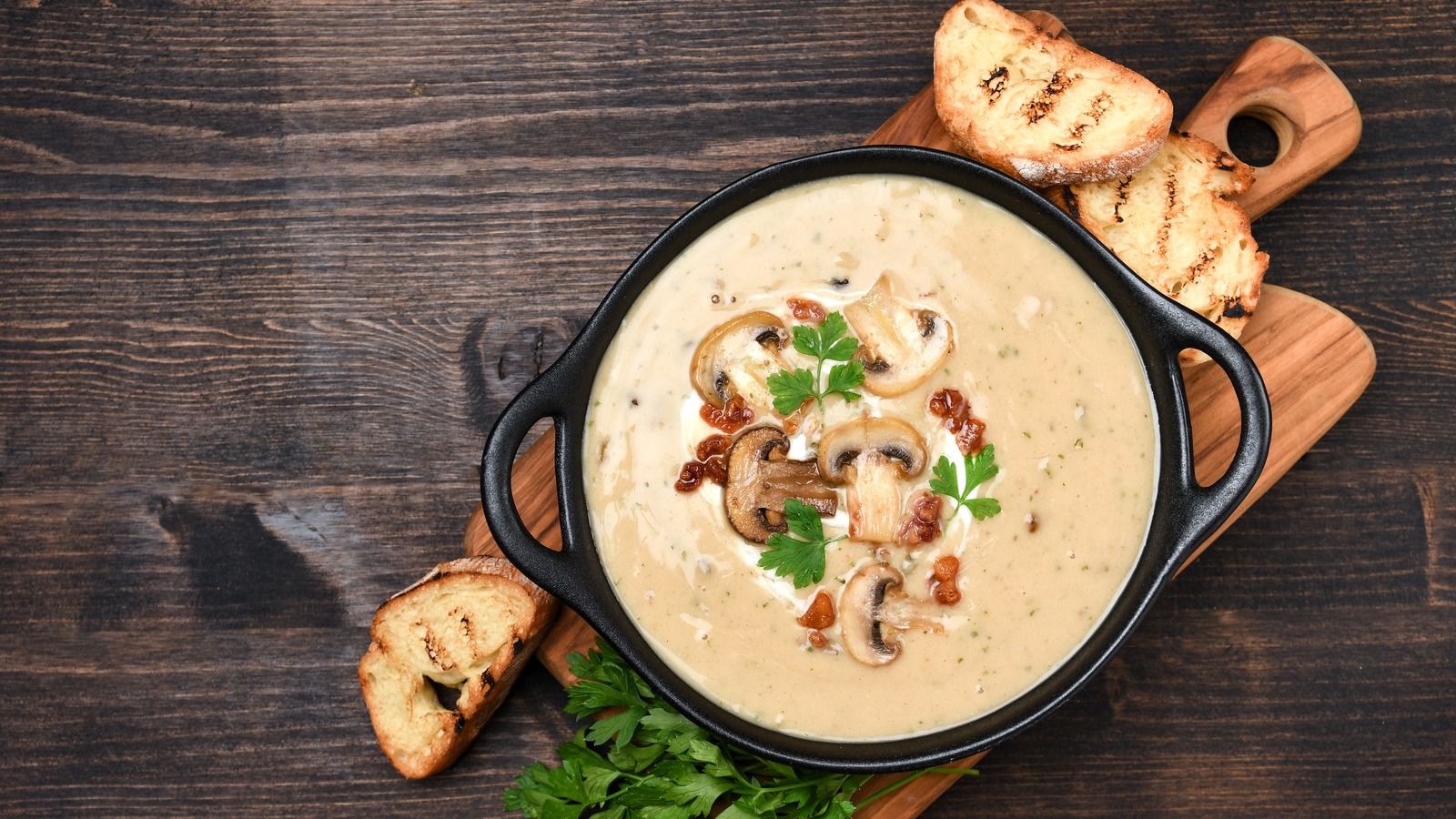There’s nothing better than a comforting bowl of hot soup, especially in colder weather. Somehow, the colder it gets, the hungrier one feels, and while broth-based soups can be great, sometimes we want a homier feeling that only thicker and creamier soup can fulfill. Soups don’t have to be relegated to side dishes or starters — when made with more substantial ingredients, they can be a delicious, satisfying meal that feeds the whole family, or even a dinner party. And the best thing is, soup is usually all cooked in one pot. That means less washing up, and more time to spend around the table, or cozying up by a fireplace.
There are plenty of ways to make a rich, decadent-feeling soup without adding cream or other dairy products. In fact, many of the ingredients on this list are non-dairy, and work just as well to add the desired level of liquid bulk. Cultures all around the world have come up with clever and delectable ways to add more body and richness to soups, whether they’re chunky, broth-based, or pureed. Many of these methods will not only make soup much more than a boring dish eaten when you’re sick, but will actually make you a better cook, inspiring experimentation with ideas you may not have tried before.
Go traditional and make a roux
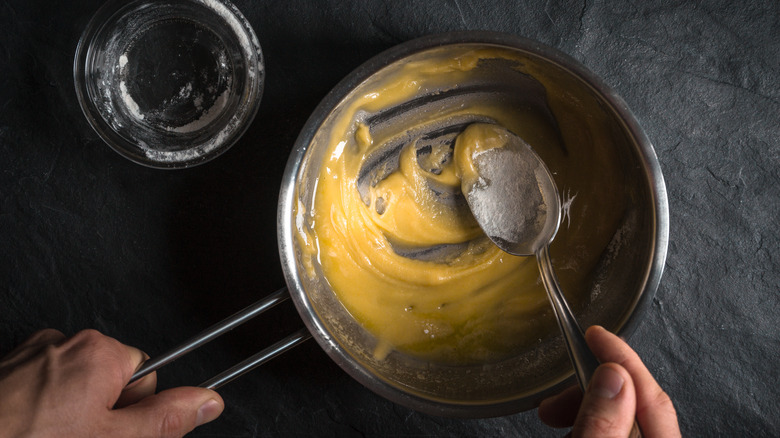
One of the oldest methods for thickening up soup is the French technique of making a roux. Made by cooking equal parts fat and flour together, it’s a great skill to have in the kitchen because you can use it to thicken all kinds of sauces or liquid-based dishes. Interestingly, the longer you cook the roux the darker it becomes, and there are four stages that are commonly recognized. It goes from being white to blond, to brown, to dark brown, and each level of cooking is used for different dishes. The lightest stage, a white roux, is often used for soups like chowders and sauces like béchamel, while the darker ones are used for dishes with deeper flavors like gumbo, gravy, and meaty stews.
The most common type of fat used for roux is butter, but you can also use oil, lard, or bacon grease — the options are many, though they may require different cooking times. As long as you use the same amount of fat to flour, you can make a roux from it. Just be careful to follow each soup recipe individually to know how long to cook roux for a velvety texture.
Potatoes are the perfect thickener
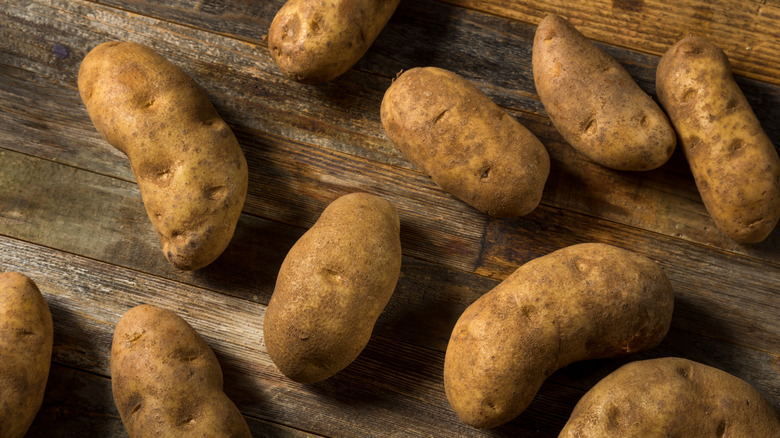
There are so many reasons to love potatoes, and this is just one more: Potatoes add body to your soup. Actually, pureed veggies are all you need for creamy soup without any dairy, and potatoes are the one of best options because they are naturally starchy and have a neutral taste. They work with basically any kind of soup because they won’t overpower the flavor. In fact, potatoes absorb spices and other flavors really well, so they make the perfect base for a soup.
All you have to do is boil your potatoes until they become soft, and then puree them. You can do this step separately, or if you’re blending up your soup anyway, just add the potatoes straight into your soup and blend everything together. The only thing to bear in mind is that potatoes usually take a while to cook, so take time into consideration if you’re using this method. This is also a convenient way to use up leftover mashed potatoes since they’ve already been cooked, and you can even use a packet of instant mash to add creaminess to your soup.
Cashew nuts will surprise you

With plant-based diets on the rise, curiosity is increasing about alternative ways to make creamy foods without using dairy products. One genius technique is using cashew nuts, which have been part of various African and Asian cuisines for centuries. These white hard nuts become softer when soaked in hot water. Then, when blended together with water or stock, they produce a velvety, cloudy concoction, which will add silkiness to your soup without the need for any other thickener.
What makes cashew nuts suitable for soup is that they are mild tasting and they’re high in fat, creating their own richness when pureed. Their dryness also helps them latch onto liquid, binding together to make a pillowy and smooth texture. That’s why cashew nuts are a popular type of nut for making vegan cheeses, milk, and yogurt. The best thing about using cashews is that you really don’t need a lot to make an impact — just grab a handful of cashews for creamy soup with the bulk you’re looking for.
Make a cream and cornstarch slurry
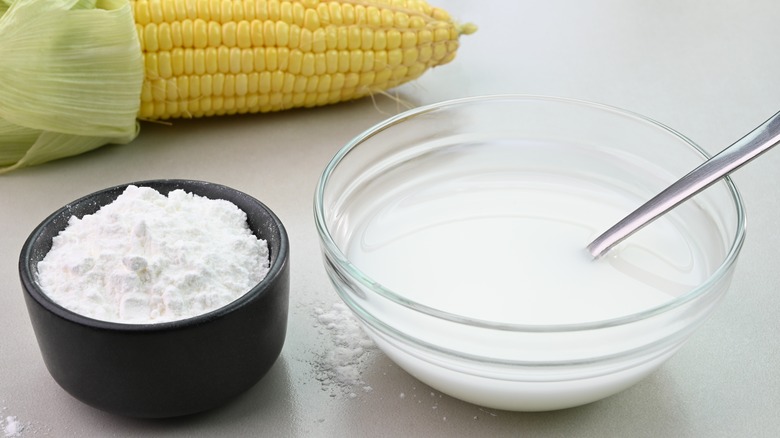
jayk67/Shutterstock
Cornstarch is one of those essential ingredients to keep in your pantry because it’s one of the most commonly used thickening agents in cooking, and also one of the easiest to use. What makes it so useful is that it has zero taste and works by binding to liquid and absorbing it, creating a thicker, more velvety result. Making a cornstarch slurry with heavy cream works with any type of sauce or soup — this is the creamy addition that will elevate your chicken noodle soup from a clear-broth version to a rich, satisfying meal.
Heavy cream will add that luxurious milky taste that you crave in cold weather, or when you’re feeling a little under the weather. It’s an easy replacement for water when making a slurry, which is just a mix of flour and water that is added at the end of cooking to thicken up soup or stews. In this case, the flour part is cornstarch, and it binds to the water particles in heavy cream. To avoid curdling the cream, make sure your soup is hot but not boiling when you add this mixture in, then watch it instantly turn your broth into a decadent, thick creation.
Another reason to love cauliflower
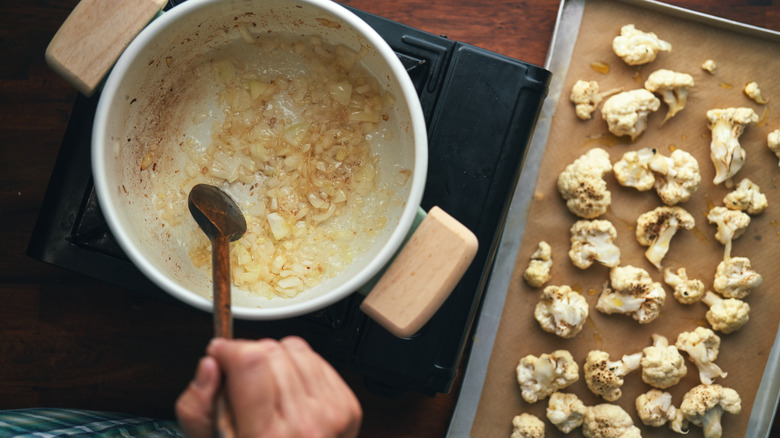
Perhaps you’ve seen what seems like too many uses for cauliflower. The fact that you can find cauliflower versions of everything — from rice to pizza bases to steak — is evidence of just how versatile this white veggie can be. While you may be thinking you’ve had enough of cauliflower alternatives to the foods you love, you’ll actually adore this back-to-basics use for it. Pureed cauliflower shines in soups, adding a satisfying silkiness that even the most picky eaters can’t deny.
When soft, cauliflower can be blended into a delightfully cloudy mixture, similarly to potatoes. The naturally white color already meets our sensibility for thinking about creaminess, and its pleasant taste can be easily paired with garlic, a range of seasonings, chicken, bacon, and more. Plus, you can make a luscious cauliflower soup by using it as your star ingredient. For an even deeper, more caramelized flavor, you can roast your cauliflower first.
Yogurt is an underrated soup ingredient

Dairy isn’t limited to just milk, cream, and butter. Many people forget that yogurt is not just a healthy snack or breakfast food, it’s an ingredient that you can use for cooking in various ways. Yogurt brings a good amount of body and adds a pleasant flavor element to your dish that is both creamy and slightly tangy, without the heft of using heavy cream. As a part of various cuisines for centuries, yogurt soup is more common than you might think.
In Turkey, yayla çorbasi is a yogurt and rice soup that’s served as an accompaniment to a heavy meal, and in Syria you’ll find yogurt and lamb soup, among other yogurt-soup variations all across the Middle East. If you can’t imagine eating yogurt in the form of hot soup, you’ll be pleased to learn that cold yogurt soup is popular too — especially in Greece and Bulgaria, where chilled yogurt soup is a summer staple.
However, yogurt is not exclusively found in yogurt soup recipes, and it can be added as a way to thicken up all kinds of soups, including lentil, chicken noodle, and pumpkin soup; the options are endless. Yogurt is also a great way to balance out spicier soups, as it mellows out spice levels, especially if you’ve added a bit too much.
Turn stale bread into soup magic
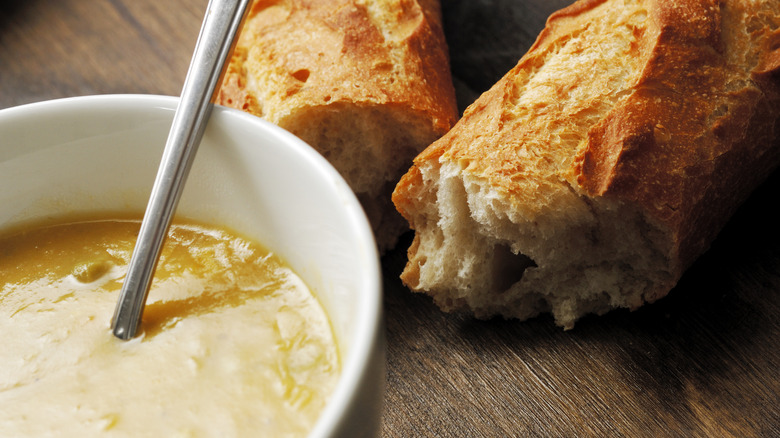
Bread that’s gone stale (but not moldy) is a handy ingredient for soup in a number of ways. The most obvious is making croutons with it to sprinkle over your soup for an extra bit of crunch. But using stale bread to make delicious soups, especially in the Mediterranean, is an age-old trick. In Spain, stale bread is added to gazpacho. In Italy, pancotto is a bread soup with multiple variations, depending on the region. In Tuscany, ribollita soup is the perfect way to use up stale bread, created with a chunky broth of tomatoes, kale, and white beans, while the bread is added to achieve a denser, richer texture.
Of course, you don’t need to wait for bread to get stale to do this. Using fresh bread works just as well, but bread is notoriously quick to turn hard, and using stale bread to make something tasty is an added benefit for those opposed to food waste. As soon as it’s added to a hot liquid, bread dissolves into a silky, starchy mixture that adds not just density, but also a pleasant wheat flavor to soup.
Maximize creaminess with almonds
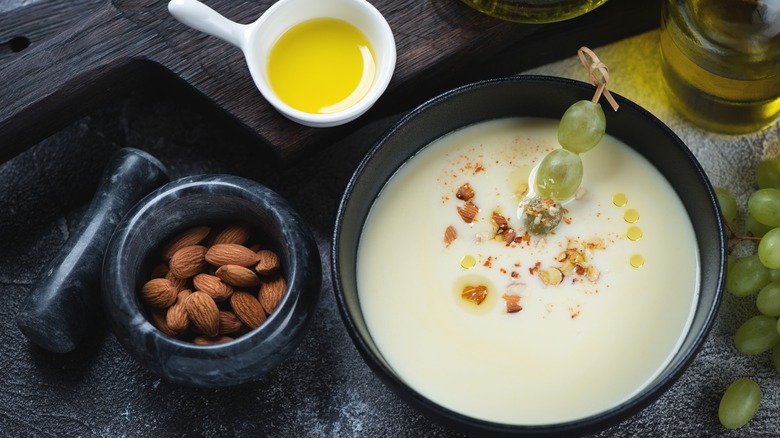
Almonds are a powerhouse nut that we’ve seen take over the alternative milk section during the past few years, and that’s for a reason. Almond flesh is meaty, with a solid amount of good fats and an incredible flavor. When blended with water, almonds turn the water into a cloudy, rich liquid, similar to dairy milk. When boosting a soup’s creaminess with almonds, you can take a shortcut and use ready-made almond milk, but in that case the almond solids have all been strained from the liquid. The nut’s solids can actually be quite integral to the density of the soup, so for the best result, use actual almonds instead.
Almonds are a crucial ingredient in ajo blanco, a cold, creamy soup from that dates back to the Middle Ages in southern Spain. Combined with garlic and bread, ajo blanco makes a luscious dish. As the almonds are blanched first, ajo blanco has a strikingly white color, which many can’t believe is possible to achieve without adding dairy products. Moroccan cuisine also features an almond-based soup made with cauliflower, but the almonds are toasted first, resulting in a gloriously golden brown color and tasty roasted flavor.
Coconut milk is an easy way to elevate soup
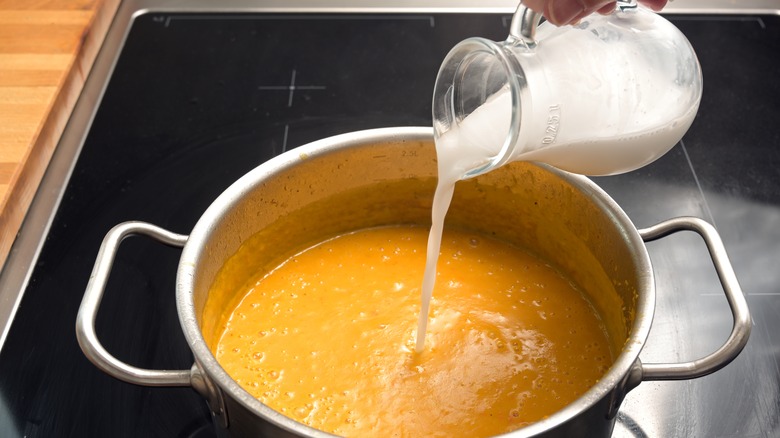
Coconut milk is central to many African and Asian cuisines, and is considered a staple of Thai cooking. Many of Thailand’s creamy curries, soups, and broths have coconut milk as their base, adding a subtle sweetness while balancing out stronger flavor profiles. Luckily, coconut milk or cream is widely accessible nowadays, and keeping some cans in your pantry will serve you well when making all kinds of soups.
One of the best things about coconut milk is how versatile it is, being useful in both savory and sweet dishes. You can use it in baked goods and desserts just as easily as in a roasted chicken dish, in curries and stews, and in multiple soup recipes. The fact that coconut milk is a plant ingredient means that it’s suitable for vegan recipes, and for people who are lactose intolerant, while still adding a milkiness that’s unmatched by other non-dairy foodstuffs. Not only can coconut milk increase the creaminess in your soup, but it can even be used to thin out pureed vegetable soups — like pumpkin soup that’s become too thick — without compromising on flavor.
Eggs are surprisingly good in soup
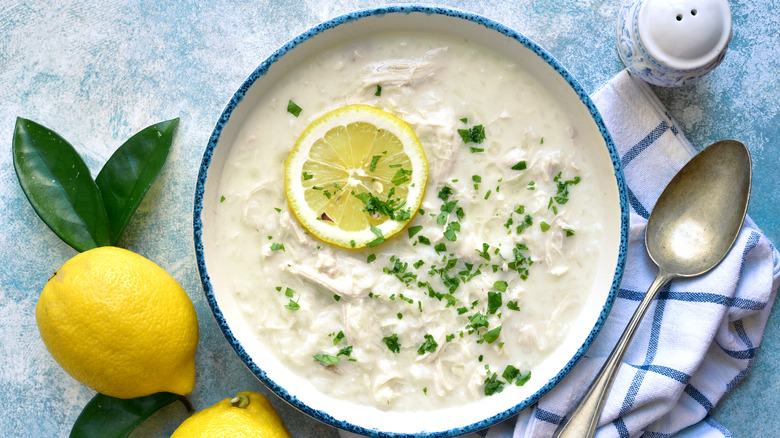
Eggs may seem like a strange soup ingredient to some, but think about it — what’s the food that gives richness to custard, carbonara sauce, hollandaise sauce, and even mayonnaise? The secret isn’t butter or cream, it’s eggs. The high fat content in eggs makes them a versatile ingredient for emulsifying and adding texture to food, and soup is no different. There are multiple ways to incorporate eggs, so don’t go cracking them into your soup without doing some research beforehand, or you might end up with poached eggs instead. Although that wouldn’t be the worst thing to happen, with a bit more technique, you could make a silky egg drop soup instead.
Eggs are also enjoyable in avgolemono, the lemony Greek chicken soup you should try. The name originates from a Greek sauce that’s made of egg, broth, and lemon juice. This tangy sauce is used in multiple Greek recipes, and is made by whisking eggs with a whole lot of lemon juice, and then tempering the mixture by adding warm broth.
Cheese is the ultimate versatile soup ingredient

Cheese is one of those foods that can make almost anything taste better. It’s hard to go wrong with cheese, because so many people around the world love it. With its wide assortment of types, you can surely find a cheese variety that even the pickiest eater will savor. Adding to the diverse lineup, you can also find myriad plant-based cheeses produced for anyone seeking a dairy-free alternative. There are so many incredible cheese options to choose from, and most of them go really well in soup.
It’s a joy to crumble feta into tomato soup and watch it melt into milkiness, or you can go with traditional cheddar and broccoli soup. You could also use cheese to make a chewy-yet-crisp crust on top, like what is often found atop French onion soup, or go the Middle Eastern route and use labneh yogurt cheese, which is sure to add velvety depth.
Impress with roasted garlic soup

Garlic lovers know what a powerful ingredient it is, and are happy to put garlic on most anything. For those who don’t like the taste of garlic, the flavor can be overpowering. The potent taste of this allium means that you only need to use a little to make an impact. However, roasting garlic whole results in a soft, pillowy texture, with a mellower and sweeter taste that even many people who dislike raw garlic enjoy. This transformation is hard to explain unless you’ve tasted how heavenly it is. Some cooks roast garlic in oil, or simply bake a whole head of garlic among their roasted veggies, and then squeeze out the buttery pulp afterward.
While it’s scrumptious as is or when spread on some toasted bread, garlic also makes for an impressive soup addition. If you choose to roast the garlic whole, let it cool first before incorporating it into soup, or you could burn your fingers. Add soft, roasted garlic to your soup stock and then blend. You’ll see it turn into a creamier, luscious soup with a mouthwatering aroma.



